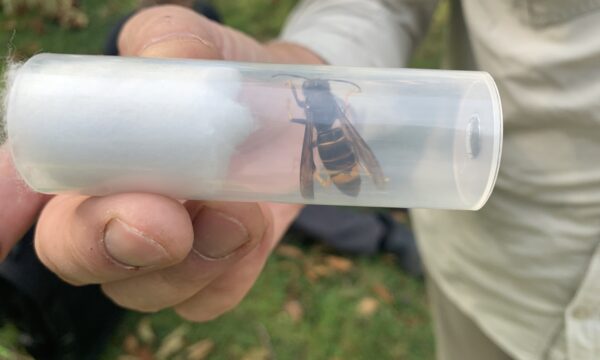
Parthenium is toxic to animals and humans when consumed in high enough quantities (© CABI)
The poisonous Parthenium hysterophorus plant is one of the world’s most destructive invasive plant species, threatening biodiversity, food security and human health across numerous countries. The herb is native to Central and South America but has spread to over 40 countries over recent decades including Australia, India, Ethiopia, Swaziland and South Africa.
The first official recording of Parthenium in Africa was in 1880 (South Africa), which became a major plant problem following natural disasters in the mid 80’s. Since then the plant has continued to spread across Southern Africa, with unaffected areas being increasingly susceptible to invasion.
Parthenium weed is incredibly destructive; it kills other plant species within close proximity via allelopathy and can wipe out entire fields of crops. The plant’s rapid growth rate and seed production make incredibly difficult to control when already successfully established in a given area. The small-sized seeds can be transported via numerous methods (animals, wind, water etc.) and can even remain viable for germination for up to ten years. Parthenium growing in agricultural areas can poison livestock which in turn can then affect human health. Symptoms include mouth ulcers, skin lesions and even death if consumed in large enough quantities. Milk and meat produced from livestock grazing on invaded land can also be found to be unfit for human consumption due to the levels of toxicity from the weed.
In terms of agriculture, the spread of Parthenium decreases the grazing capacity of the

A farmer in Kenya manually removing Parthenium from his field (© CABI)
land; it can degrade what was once suitable land for farming purposes, resulting in major economic losses to smallholder farmers. If left unmanaged this weed can cause crop yield losses of up to 95%, with what little is successfully harvested potentially being of much less commercial value due to contamination.
Physically removing the weed is only appropriate for small infestations but does require the removal of the entire root system before seeds are produced. The use of machines to remove this plant is not advised due to the likely potential spread of seeds to unaffected areas. Herbicides have been show to be effective against Parthenium; however adequate follow-ups are needed to ensure new weeds are also removed and killed. Intensive chemical treatments also may not be suitable for agriculture areas or may be prohibited by national laws and regulations. Herbicide chemicals can also be expensive, making it unsustainable for larger areas or poorer farming communities.

The biocontrol agent cocklebur rust (P. xanthii) symptoms on a leaf (© Gerald Holmes, Bugwood.org)
Rather than trying to remove the weed infestation from an area, biocontrol is a method which uses the natural enemies of Parthenium to slow down the spread of already existing populations. This is a promising method for combating the weed and is much more cost-effective than other tools such as herbicides. An example of biocontrol measures already being implemented is the release of four insect control species in South Africa, a leaf rust fungus (Puccinia xanthii), a stem-boring weevil (Listronotus setosipennis), a seed-feeding weevil (Smicronyx lutulentus) and a leaf-feeding beetle (Zygogramma bicolorata). Although results have currently shown little impacts on Parthenium populations, it is hoped that this will steadily increase over time, particularly the leaf-feeding beetle and the stem-boring weevil.
Biocontrol alone is not likely to have a great impact on the global Parthenium issue, however with increased awareness of how to appropriately tackle smaller infestations and good land management practices such as increasing natural grass cover, it is hoped that the invasion of this toxic weed will not damage currently unaffected areas in the future and reduce the impact being felt on already invaded regions.
If you would like to read further about Parthenium and management strategies being implemented, please see the links below
7 Comments
Leave a Reply
Related News & Blogs
Training on mass production of entomopathogenic nematodes for biological control of invasive insect pests
A team of global experts in the production of biocontrol agent provided a practical training on the mass culture of entomopathogenic nematodes at the Biocontrol Agent Facility of Rwanda Agriculture and Animal Resource Development Board (RAB), writes Dr…
20 December 2023





[…] 9. Parthenium: Controlling the world’s most destructive toxic weed (May) […]
TONY SHANAHAN,
Will tiny red extra couple of weeks of growing time in winter season provide us with a bumper crop of Poison Ivy to harvest this season? Who knows? We can look at the past couple of years though for clues.
Thanks.
Nice post! Thanks for sharing amazing content.
Biocontrol alone is not likely to have a great impact on the global Parthenium issue, however with increased awareness of how to appropriately tackle smaller infestations and good land management practices such as increasing natural grass cover, it is hoped that the invasion of this toxic weed will not damage currently unaffected areas in the future and reduce the impact being felt on already invaded regions.
thanks for sharing
nice
very nice sharing thanks